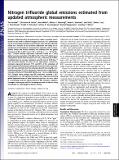| dc.contributor.author | Arnold, Tim | |
| dc.contributor.author | Harth, C. M. | |
| dc.contributor.author | Muhle, Jens | |
| dc.contributor.author | Manning, Alistair J. | |
| dc.contributor.author | Salameh, Peter K. | |
| dc.contributor.author | Kim, Jooil | |
| dc.contributor.author | Steele, L. Paul | |
| dc.contributor.author | Petrenko, Vasilii V. | |
| dc.contributor.author | Severinghaus, Jeffrey P. | |
| dc.contributor.author | Baggenstos, Daniel | |
| dc.contributor.author | Weiss, Ray F. | |
| dc.contributor.author | Ivy, Diane J | |
| dc.date.accessioned | 2013-08-08T17:40:13Z | |
| dc.date.available | 2013-08-08T17:40:13Z | |
| dc.date.issued | 2013-01 | |
| dc.date.submitted | 2012-08 | |
| dc.identifier.issn | 0027-8424 | |
| dc.identifier.issn | 1091-6490 | |
| dc.identifier.uri | http://hdl.handle.net/1721.1/79808 | |
| dc.description.abstract | Nitrogen trifluoride (NF[subscript 3]) has potential to make a growing contribution to the Earth’s radiative budget; however, our understanding of its atmospheric burden and emission rates has been limited. Based on a revision of our previous calibration and using an expanded set of atmospheric measurements together with an atmospheric model and inverse method, we estimate that the global emissions of NF[subscript 3 ] in 2011 were 1.18 ± 0.21 Gg⋅y[superscript −1], or ∼20 Tg CO[subscript 2]-eq⋅y[superscript−1] (carbon dioxide equivalent emissions based on a 100-y global warming potential of 16,600 for NF[subscript 3]). The 2011 global mean tropospheric dry air mole fraction was 0.86 ± 0.04 parts per trillion, resulting from an average emissions growth rate of 0.09 Gg⋅y[superscript −2] over the prior decade. In terms of CO[subscript 2] equivalents, current NF[subscript 3] emissions represent between 17% and 36% of the emissions of other long-lived fluorinated compounds from electronics manufacture. We also estimate that the emissions benefit of using NF[subscript 3] over hexafluoroethane (C[subscript 2]F[subscript 6]) in electronics manufacture is significant—emissions of between 53 and 220 Tg CO[subscript 2]-eq⋅y[superscript −1] were avoided during 2011. Despite these savings, total NF[subscript 3] emissions, currently ~10% of production, are still significantly larger than expected assuming global implementation of ideal industrial practices. As such, there is a continuing need for improvements in NF[subscript 3] emissions reduction strategies to keep pace with its increasing use and to slow its rising contribution to anthropogenic climate forcing. | en_US |
| dc.description.sponsorship | NASA Upper Atmospheric Research Program | en_US |
| dc.language.iso | en_US | |
| dc.publisher | National Academy of Sciences (U.S.) | en_US |
| dc.relation.isversionof | http://dx.doi.org/10.1073/pnas.1212346110 | en_US |
| dc.rights | Article is made available in accordance with the publisher's policy and may be subject to US copyright law. Please refer to the publisher's site for terms of use. | en_US |
| dc.source | PNAS | en_US |
| dc.title | Nitrogen trifluoride global emissions estimated from updated atmospheric measurements | en_US |
| dc.type | Article | en_US |
| dc.identifier.citation | Arnold, T., C. M. Harth, J. Muhle, A. J. Manning, P. K. Salameh, J. Kim, D. J. Ivy, et al. “Nitrogen trifluoride global emissions estimated from updated atmospheric measurements.” Proceedings of the National Academy of Sciences 110, no. 6 (February 5, 2013): 2029-2034. | en_US |
| dc.contributor.department | Massachusetts Institute of Technology. Department of Earth, Atmospheric, and Planetary Sciences | en_US |
| dc.contributor.mitauthor | Ivy, Diane J. | en_US |
| dc.relation.journal | Proceedings of the National Academy of Sciences of the United States of America | en_US |
| dc.eprint.version | Final published version | en_US |
| dc.type.uri | http://purl.org/eprint/type/JournalArticle | en_US |
| eprint.status | http://purl.org/eprint/status/PeerReviewed | en_US |
| dspace.orderedauthors | Arnold, T.; Harth, C. M.; Muhle, J.; Manning, A. J.; Salameh, P. K.; Kim, J.; Ivy, D. J.; Steele, L. P.; Petrenko, V. V.; Severinghaus, J. P.; Baggenstos, D.; Weiss, R. F. | en_US |
| mit.license | PUBLISHER_POLICY | en_US |
| mit.metadata.status | Complete | |
